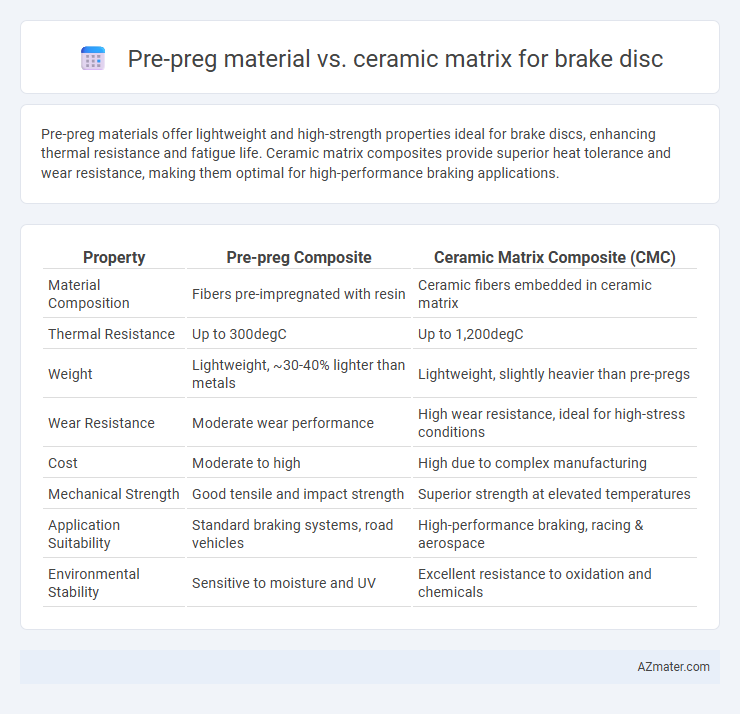Pre-preg materials offer lightweight and high-strength properties ideal for brake discs, enhancing thermal resistance and fatigue life. Ceramic matrix composites provide superior heat tolerance and wear resistance, making them optimal for high-performance braking applications.
Table of Comparison
| Property | Pre-preg Composite | Ceramic Matrix Composite (CMC) |
|---|---|---|
| Material Composition | Fibers pre-impregnated with resin | Ceramic fibers embedded in ceramic matrix |
| Thermal Resistance | Up to 300degC | Up to 1,200degC |
| Weight | Lightweight, ~30-40% lighter than metals | Lightweight, slightly heavier than pre-pregs |
| Wear Resistance | Moderate wear performance | High wear resistance, ideal for high-stress conditions |
| Cost | Moderate to high | High due to complex manufacturing |
| Mechanical Strength | Good tensile and impact strength | Superior strength at elevated temperatures |
| Application Suitability | Standard braking systems, road vehicles | High-performance braking, racing & aerospace |
| Environmental Stability | Sensitive to moisture and UV | Excellent resistance to oxidation and chemicals |
Introduction to Advanced Brake Disc Materials
Pre-preg materials for brake discs consist of fiber-reinforced composites impregnated with resin, offering lightweight properties and excellent thermal stability under moderate braking conditions. Ceramic matrix composites (CMCs) provide superior high-temperature resistance, wear performance, and reduced thermal expansion, making them ideal for high-performance and heavy-duty brake applications. Advanced brake disc materials like pre-preg and ceramic matrix composites significantly enhance braking efficiency, durability, and heat dissipation compared to traditional cast iron discs.
Overview of Pre-Preg Materials
Pre-preg materials for brake discs consist of fiber reinforcements pre-impregnated with resin, offering controlled fiber alignment and enhanced mechanical properties. These composites provide superior strength-to-weight ratios and improved thermal stability compared to traditional materials. Pre-preg manufacturing allows precise customization of layup patterns, resulting in consistent performance and reduced manufacturing defects.
Understanding Ceramic Matrix Composites
Ceramic matrix composites (CMCs) used in brake discs offer superior thermal resistance and durability compared to pre-preg carbon fiber materials, making them ideal for high-performance applications. CMCs consist of ceramic fibers embedded within a ceramic matrix, enhancing toughness and resistance to thermal shock, which is critical in braking systems exposed to extreme temperatures. This composite structure allows CMC brake discs to maintain structural integrity under intense friction and heat, outperforming traditional pre-preg-based brake discs in longevity and performance.
Key Performance Differences
Pre-preg composites offer higher tensile strength and lighter weight compared to ceramic matrix materials, enhancing overall vehicle performance and fuel efficiency. Ceramic matrix brake discs exhibit superior thermal stability and wear resistance, enabling better heat dissipation and longevity under extreme braking conditions. The choice between pre-preg and ceramic matrix materials hinges on balancing weight reduction with thermal performance requirements for specific automotive applications.
Thermal Conductivity and Heat Dissipation
Pre-preg composites for brake discs typically exhibit lower thermal conductivity compared to ceramic matrix composites, which can exceed 20 W/m*K, enabling superior heat dissipation under extreme braking conditions. Ceramic matrix materials maintain structural integrity at high temperatures up to 1,200degC, significantly reducing thermal degradation and brake fade compared to pre-preg composites. Enhanced thermal conductivity in ceramic matrix brake discs directly contributes to faster heat dispersion, improving braking performance and extending the lifespan of the braking system.
Weight and Structural Advantages
Pre-preg materials offer significant weight reduction for brake discs due to their high strength-to-weight ratio, making them ideal for performance vehicles requiring enhanced agility. Ceramic matrix composites provide superior structural advantages such as exceptional thermal stability, high wear resistance, and improved durability under extreme braking conditions. The choice between pre-preg and ceramic matrix materials depends on prioritizing lightweight design or maximizing thermal and mechanical performance in brake disc applications.
Durability and Wear Resistance
Pre-preg materials offer enhanced durability through reinforced fiber layers that provide superior structural integrity under repeated thermal and mechanical stress, reducing wear and extending brake disc lifespan. Ceramic matrix composites exhibit exceptional wear resistance due to their high hardness, elevated temperature tolerance, and resistance to oxidation, making them ideal for high-performance brake applications with minimal material degradation. Both materials significantly outperform traditional metals, with ceramic matrix composites excelling in extreme conditions and pre-pregs providing a cost-effective balance of durability and wear resistance.
Cost Comparison and Manufacturing Complexity
Pre-preg composite brake discs generally offer lower manufacturing costs due to less specialized equipment and shorter processing times compared to ceramic matrix composites (CMC), which require high-temperature sintering and controlled atmospheres, driving up production expenses. The complexity of producing ceramic matrix brake discs involves intricate layering and precise thermal treatments, increasing both time and labor costs relative to the more straightforward lay-up and curing processes used for pre-preg materials. Cost efficiency in pre-preg materials makes them favorable for mass-market applications, while the high durability and thermal resistance of ceramic matrix composites justify their expense in high-performance or luxury vehicle segments.
Application Suitability: Racing vs. Road Use
Pre-preg materials offer excellent performance in racing brake discs due to their lightweight nature and superior thermal conductivity, which enables rapid heat dissipation during high-speed braking. Ceramic matrix composites excel in road use, providing enhanced durability, corrosion resistance, and longer service life under varying environmental conditions. Racing applications demand materials that balance weight and thermal management, while road use prioritizes longevity and consistent performance in everyday scenarios.
Future Trends in Brake Disc Technology
Pre-preg materials offer lightweight properties and excellent fatigue resistance, making them ideal for high-performance brake discs requiring rapid thermal dissipation and durability. Ceramic matrix composites (CMCs) provide superior high-temperature stability, reduced wear, and enhanced braking efficiency, driving their adoption in advanced automotive and aerospace braking systems. Future trends emphasize hybrid solutions combining pre-preg composites and ceramic matrices to optimize performance, weight reduction, and cost-effectiveness in next-generation brake disc technologies.

Infographic: Pre-preg material vs Ceramic matrix for Brake disc
 azmater.com
azmater.com